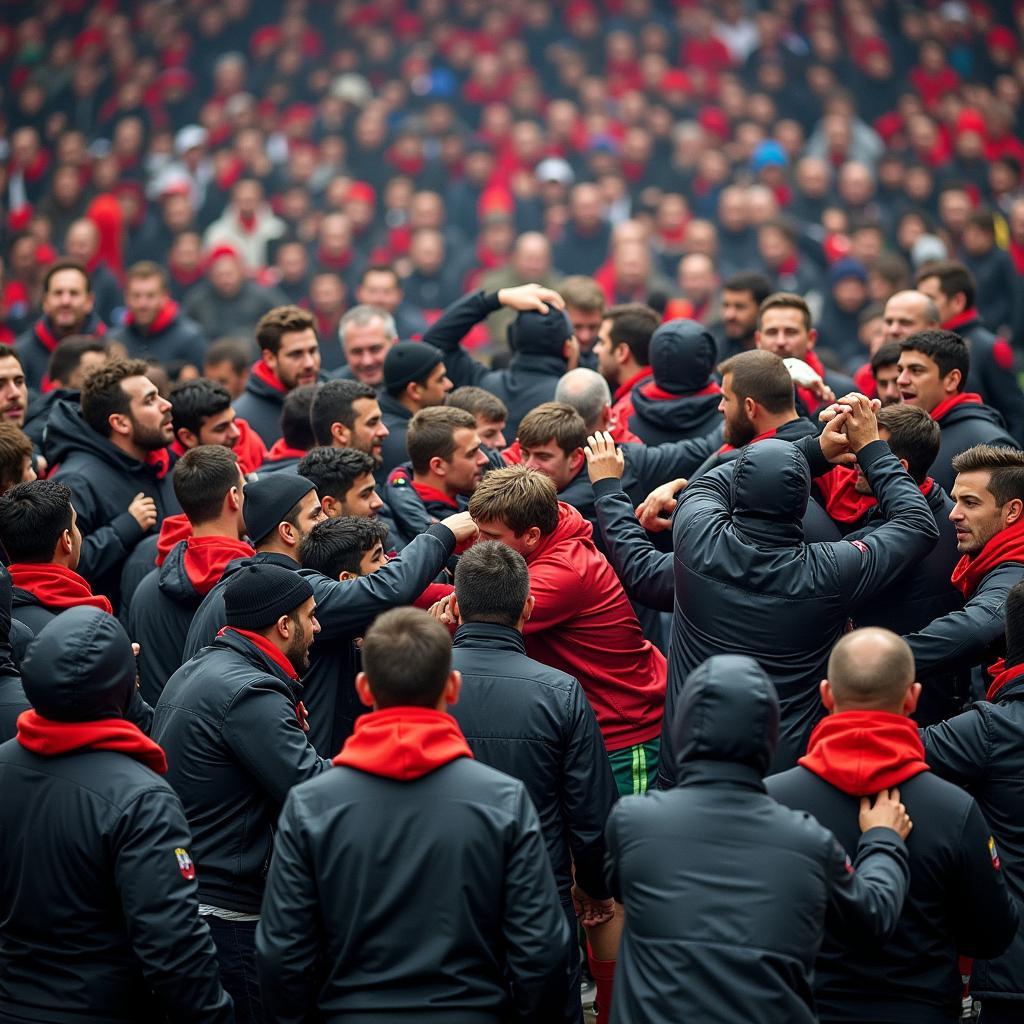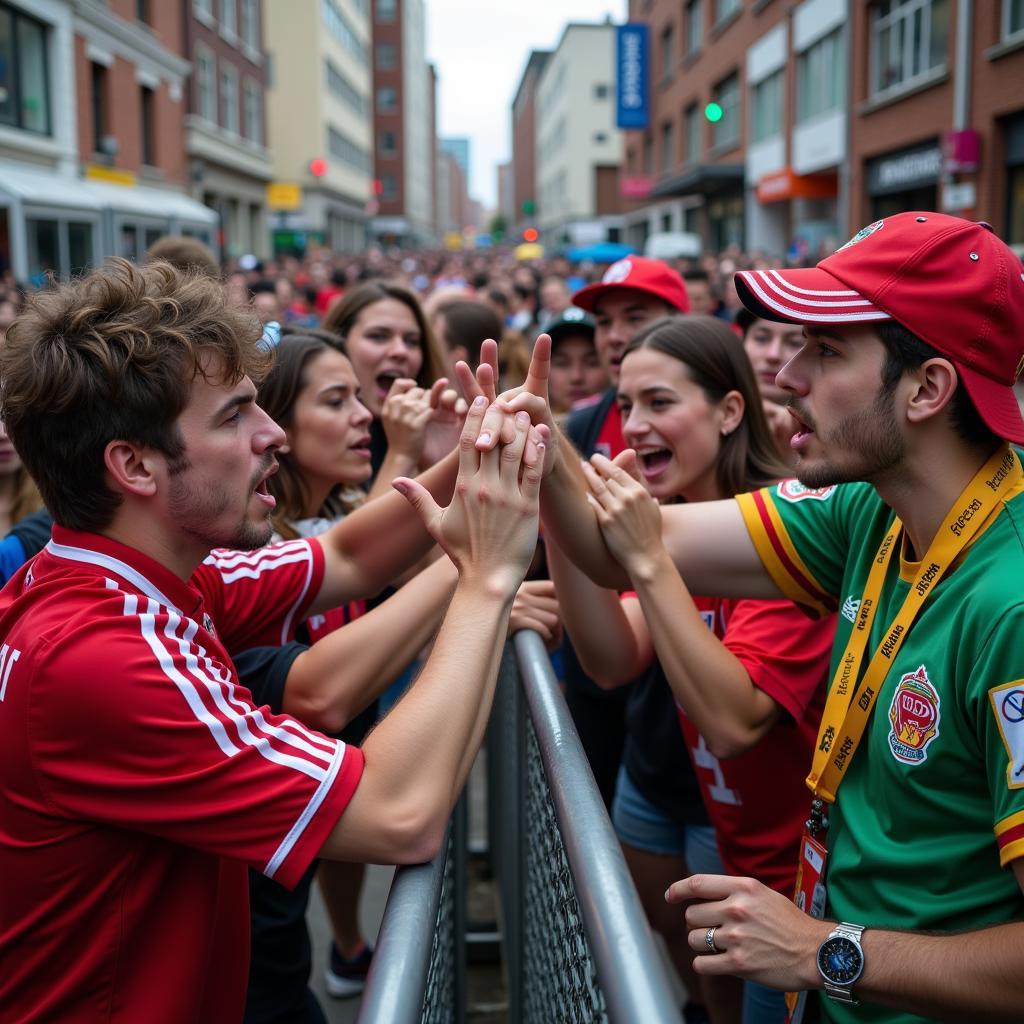The phrase “Fans Attack Fans” evokes a sense of unease, a stark reminder that the beautiful game can sometimes be marred by ugly incidents. While sports have the power to unite, they can also, unfortunately, become a catalyst for violence and aggression between individuals or even groups of supporters. This article delves into the concerning phenomenon of fan-on-fan violence, examining its underlying causes, psychological triggers, and potential solutions for creating a safer and more inclusive sporting environment.
The Psychology of Mob Mentality: Why Do Fans Turn on Each Other?
One of the key factors contributing to fan-on-fan violence is the phenomenon of “mob mentality.” When individuals become part of a large, emotionally charged crowd, their sense of personal responsibility and restraint can diminish. Anonymity within the group, coupled with a heightened sense of belonging and shared identity, can lead to deindividuation, a psychological state where individuals feel less inhibited and more likely to engage in impulsive, aggressive behavior they wouldn’t typically consider on their own.
 Fans clashing in a stadium
Fans clashing in a stadium
Furthermore, the presence of alcohol or drugs can exacerbate these tendencies, impairing judgment, lowering inhibitions, and increasing the likelihood of aggression. This toxic mix of social and psychological factors can create a volatile atmosphere where even minor disagreements or provocations can escalate into violence.
Tribalism and Rivalry: Fueling the Fire of Fan Violence
Another significant contributor to fan-on-fan aggression is the deep-seated sense of tribalism inherent in sports fandom. Supporting a particular team often becomes an integral part of an individual’s identity, fostering a sense of belonging and camaraderie with fellow fans. However, this sense of “us vs. them” can also lead to prejudice and hostility towards supporters of rival teams, creating a breeding ground for conflict and aggression.
 Fans of opposing teams facing off
Fans of opposing teams facing off
This tribalistic mentality is often fueled by a desire for social dominance and the need to assert one’s group as superior. This can manifest in various forms, from verbal abuse and taunting to physical confrontations and vandalism, all aimed at denigrating and intimidating the opposing side.
Beyond the Stands: The Rise of Online Fan Violence
While fan violence has traditionally been associated with physical confrontations in and around stadiums, the digital age has ushered in a new era of online aggression. Social media platforms, while offering fans unprecedented access to their favorite teams and players, have also become breeding grounds for cyberbullying, hate speech, and online harassment among fans.
 Screenshots of hateful comments on a social media post
Screenshots of hateful comments on a social media post
The anonymity provided by the internet often emboldens individuals to engage in behavior they wouldn’t dream of exhibiting in face-to-face interactions. This can have a significant psychological impact on victims, leading to emotional distress, anxiety, and even depression.
Curbing Fan Violence: A Multifaceted Approach
Addressing the complex issue of fan-on-fan violence requires a multifaceted approach involving stakeholders across the sporting world, including:
- Sports Organizations: Implementing stricter security measures, increasing police presence at high-risk matches, and issuing stadium bans for individuals involved in violent incidents.
- Clubs and Teams: Promoting positive fan culture initiatives, fostering dialogue between rival fan groups, and actively condemning all forms of violence and discrimination.
- Social Media Platforms: Enforcing stricter community guidelines, developing effective mechanisms for reporting and removing abusive content, and collaborating with law enforcement to hold perpetrators accountable.
Creating a Safer and More Inclusive Sporting Environment
Ultimately, tackling fan-on-fan violence requires a fundamental shift in attitudes and behaviors. It’s about recognizing that passion for one’s team should never come at the expense of another’s safety or well-being.
By promoting respect, understanding, and empathy among fans, we can create a sporting environment where everyone feels safe, welcome, and able to enjoy the beautiful game without fear of violence or intimidation.
FAQ
1. What are some common triggers for fan violence?
Answer: Common triggers include alcohol consumption, intense rivalry, perceived injustices by officials, and pre-existing social tensions.
2. How can social media contribute to fan-on-fan aggression?
Answer: Social media provides a platform for anonymity and can amplify aggressive behavior, leading to cyberbullying and online harassment.
3. What role can clubs and teams play in curbing fan violence?
Answer: Clubs can promote positive fan culture, facilitate dialogue between rival fan groups, and implement stricter security measures.
4. What can individuals do to prevent fan violence?
Answer: Individuals can challenge aggressive behavior, report incidents to authorities, and promote respectful interactions within their own fan communities.
Need Help or Have Questions?
Contact us:
Phone: 0903426737
Email: fansbongda@gmail.com
Address: Tổ 9, Khu 6, Phường Giếng Đáy, Thành Phố Hạ Long, Giếng Đáy, Hạ Long, Quảng Ninh, Việt Nam.
Our customer support team is available 24/7 to assist you. You can also find more information on related topics like “Vietnamese fans attack winning fans” and “Vietnamese fans attack referees’ social media” on our website.


